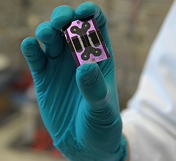Top story
Zurich, Switzerland, 13 November 2013—The Swiss National Research Fund is supporting the three-year research project REPCOOL as part of its Sinergia program. This project is headed by IBM Research – Zurich and brings together scientists from ETH Zurich, the Paul Scherrer Institute in Villigen and the University of Lugano in a joint collaboration to investigate an "electronic circulation system" for future 3D computer chips. Inspired by the structure of the human brain, the research team will develop a microchannel system with an electrochemical flow battery that can simultaneously power and cool 3D chip stacks. The ultimate goal is to develop a supercomputer the size of a PC.
 This groundbreaking approach is modelled after the structure and power supply system of the brain, where blood capillaries serve both to cool it and to supply it with energy. Compared to today's top computers, however, the human brain is roughly 10,000 times denser and 10,000 times more energy-efficient. The REPCOOL research team believes that their approach could reduce the size of a computer with a performance of 1 petaflop/s from the dimensions of a school classroom to that of an average PC, or in other words to a volume of about 10 liters.
This groundbreaking approach is modelled after the structure and power supply system of the brain, where blood capillaries serve both to cool it and to supply it with energy. Compared to today's top computers, however, the human brain is roughly 10,000 times denser and 10,000 times more energy-efficient. The REPCOOL research team believes that their approach could reduce the size of a computer with a performance of 1 petaflop/s from the dimensions of a school classroom to that of an average PC, or in other words to a volume of about 10 liters.
Until now, the number of transistors on a chip and hence computer performance has doubled every 18 months in accordance with Moore's Law. The downside is that their power consumption has also grown at the same pace. This trend of ever-increasing computer performance is expected to be pushed to the zeta scale in the next few decades. Such systems would be able to perform 1021 — a 1 followed by 21 zeros — computational operations per second, which is roughly 30,000 times more than today's best computer systems can do. However, based on current technologies, a supercomputer of this capacity would devour more than the entire global production of electricity.
3D chip architectures, which consist of three-dimensional chip stacks, promise to increase the performance and energy efficiency of future computers. Such architectures reduce the chip's footprint, shorten the data connections and vastly increase the bandwidth for data transmission within the chip. To achieve this future chip technology, the research team will face two formidible challenges. First, complex chip stacks become very hot and produce several kW/cm3 (kilowatts per cubic centimeter) of heat, which constitutes a performance density far greater than that of today's combustion engines. Second, the energy supply to the chip base via electronic connections called pins will no longer be sufficient to provide the chip stack with the required energy of several kV/cm3.
To cool 3D chips efficiently, scientists at IBM Research – Zurich have already developed fluid-cooled test systems with capillary cooling structures that allow the fluid to flow between the individual chip layers, a process called "interlayer cooling" that achieves a cooling efficiency of 3 kW/cm3.
The REPCOOL project team will take this approach one step further by developing an integrated cooling and energy distribution system based on an electrochemical flow battery to solve the power supply problem in a sustainable way. Their approach is to distribute the energy electrochemically via what are known as redox chemicals in the capillary fluid instead of through electrical wires. Similar to a battery, the fluid serves as an electrolyte between two electrodes. The electrode pairs consist of a central electrode that charges the fluid and numerous receiver electrodes on the layers of the 3D chip stack. Large electrochemical flow batteries of this kind already exist for such purposes as buffer storage of electricity from renewable sources, but this technology must be improved and miniaturized for use in future chip stacks.
To achieve their ambitious goal, the research team will conduct extensive investigations into the individual components of 3D chips, including the processor layers, the electrodes, the electrolytes and the membranes between the layers. To that end, the project is divided into four subprojects, in which each partner will investigate a different component. Professor Michele Parrinello of the University of Lugano and Dr. Alessandro Curioni of IBM Research – Zurich will focus on modelling the redox pairs and the reaction mechanism with ab initio simulations in order to obtain a deeper understanding of the chemical reactions that take place. Professor Thomas J. Schmidt of the Electrochemistry Laboratory at the Paul Scherrer Institute will perform the experimental characterization and improve the electrochemical properties of selected systems. He and his team will develop suitable electrochemical electrodes and membranes to separate the electrodes in the flow battery. Professor Dimos Poulikakos at the Institute for Energy Technology of ETH Zurich will focus on optimizing the transport of electrolytes and heat in the fluids between the chip levels in order to achieve the highest possible performance density of the miniaturized flow battery. In the fourth subproject, Dr. Bruno Michel and his team at IBM Research – Zurich will integrate these systems into a prototype, in addition to testing and optimizing the components and the integrated system.